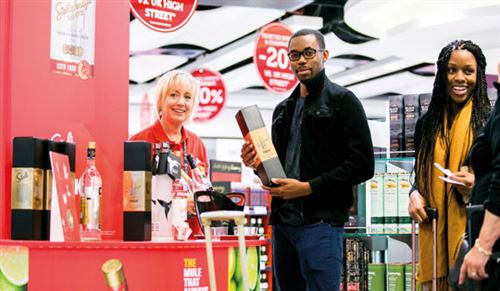By Blackjack Promotions // Wed 23 rd August 2017 Retailers and brand operating in the travel retail space need to understand how the airport audience changes as time progresses and tailor their product offering and marketing accordingly, says Fiona Tindall of experiential and staffing agency Blackjack Promotions.
Airports are a very special space for brands and retailers - they offer a captive audience of consumers with time to fill while they wait for the flights, money in their pockets and an open-ness to new experiences and new products.
But if marketers are to reach air travellers in the airport environment successfully, they have to understand that they are not dealing with one single audience, but with many. The demographics of the flying public will change hour by hour, day by day, depending on where flights are coming from or going to.
Time of year also matters, with passenger profiles changing according to the season - plus airports, retailers and brands need to be sensitive to local holidays and festivals.
In the travel retail industry, we call this 'Destination Targeting': analysing the consumer makeup in a particular airport as time goes by and adapting product offering and marketing messages (often multiple times across the course of a single day) to reflect changes in spending power, language and cultural preferences.
Because of the way global air travel works, flights to and from particular countries and regions tend to be grouped together into a time slot, rather than evenly spread across the day or week. It depends on where and in what time zone the airport is, of course: but as an example, flights to China from Heathrow tend to depart between 10am and 4pm every day. Then the cycle will move on to another region - Russia, for example.
Why does this matter? Because different nationalities like to buy things and they like to marketed to in different ways. All of them however, really appreciate being able to talk to a sales person or brand ambassador who speaks their own language.
The Chinese, for example, have a strong gifting and wrapping culture, while Russians love to own the latest fashion labels.
This is why more and more marketers are actively turning to Destination Targeting, spotlighting the highest-spending nationalities, directly targeting them at airports around relevant flight times and in the relevant terminals and providing native language speakers to help with their every need - from shopping to finding their way around the airport.
As the balance of spending power shifts around the world, destination targeting is set to become an even more important skill for travel retail brands to adopt and understand. And with airports under pressure, targeting the higher spending nations makes good business sense.
There is an absolute wealth of information at the fingertips of airports and retailers about the profile of customers, along with a very good idea of what those passengers like to buy.
Furthermore, there is the all-important airside dwell time pre-boarding where airports and retailers essentially have a captive audience looking for distraction and retail therapy.
It is essential, however, that any Destination Targeting plans are well researched and well executed - getting it wrong is not an option.
This is particularly relevant with destination targeted events, as mimicking a national costume or tradition in an inappropriate way could have disastrous consequences!
Airports, retailers and brands that can manage the logistics of changing the product and the promotion and fine-tuning their focus through the course of one day will be on to a winner.
Marketers also need to exploit the value of the location the airport is in - research with air travellers consistently shows that they prefer airports which celebrate their own national, regional or local identities over those which could be in any city in any country of the world.
Take a look at how Heathrow's retail outlets create a 'sense of place' with British brands and iconic British food and beverage on offer. This quintessentially British approach has its own appeal to other nationalities who want to savour 'Britishness' while they can.
Planning and research are paramount. Getting Destination Targeting right needs attention to detail, sensitivity to cultures and customs and a focus on how best to achieve the desired outcome.
Profitability and ROI are always a consideration for any activation or investment in skilled staff; but that does not mean to say that the cheapest option will be the best. Never compromise on the quality of an event or experiential activity. Return on investment will always be greater for a well-executed activity that respects and audience's traditions and customs than for something at the other, cheaper end of the spectrum.
To discuss incorporating Destination Targeting into your brand campaigns, please get in touch with Fiona Tindall on 020 3617 5149.
|

|